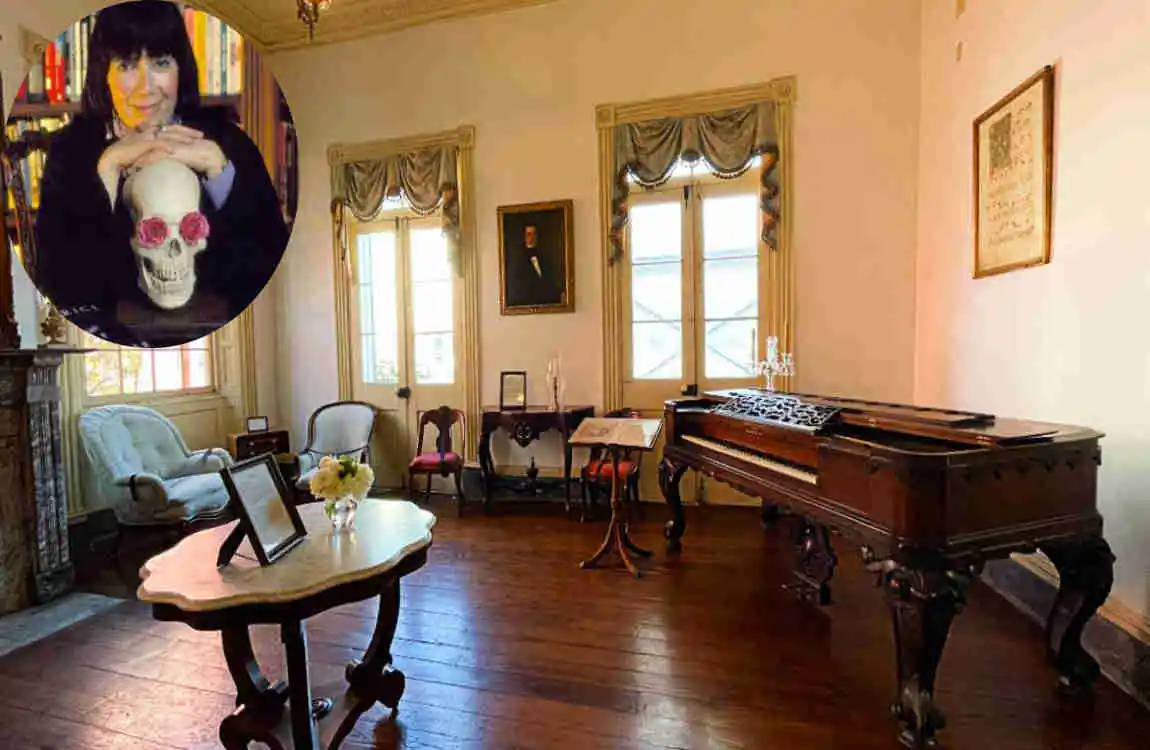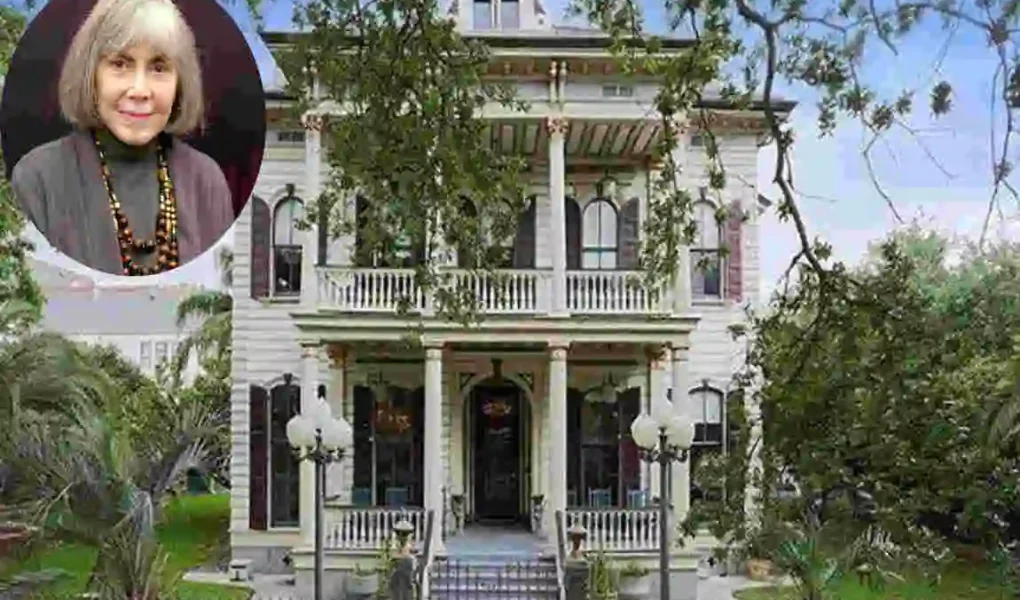Imagine stepping into a world where the lines between reality and fiction blur, where every corner whispers tales of vampires and ancient mysteries. This is the enchanting allure of Anne Rice’s home in New Orleans. As a bestselling author known for her spellbinding Vampire Chronicles and novels deeply rooted in the soul of New Orleans, Anne Rice’s influence on gothic literature and culture is undeniable
| Personal Info | Details |
|---|---|
| Birth Name | Howard Allen Frances O’Brien |
| Date of Birth | October 4, 1941 |
| Place of Birth | New Orleans, Louisiana |
| Date of Death | December 11, 2021 |
| Last Known Residence | Rancho Mirage, California |
| Notable Works | The Vampire Chronicles, Interview with the Vampire |
| Net Worth at Death | Approximately $60 million |
The Legacy of Anne Rice and Her Connection to New Orleans

Anne Rice’s New Orleans Roots
Born and raised in New Orleans, Anne Rice’s connection to the city runs deep. Her childhood memories of the city’s vibrant culture, historic architecture, and hauntingly beautiful atmosphere shaped her storytelling from the very beginning. As you delve into her novels, you can’t help but feel the essence of New Orleans permeating every page.
The Influence of New Orleans on Anne Rice’s Writing
New Orleans, with its rich history and mystical aura, provided the perfect backdrop for Anne Rice’s gothic tales. The city’s unique blend of French, Spanish, and Creole influences, combined with its reputation for voodoo, ghosts, and the supernatural, inspired Rice to craft stories that transport readers to another world. Her novels, such as “Interview with the Vampire” and “The Witching Hour,” are deeply intertwined with the city’s lore and charm.
Anne Rice’s Home as a Reflection of Her Literary World
Anne Rice’s home in New Orleans is not just a residence; it is a testament to the city’s haunting allure and a reflection of her literary universe. The modren house itself is a character in her stories, embodying the gothic, mystical, and historic themes that define her work. As we explore the interior and exterior of this iconic home, you’ll discover how every detail pays homage to the enchanting world Anne Rice created.
Location and Architectural Overview of Anne Rice’s Home
| House Name/Location | Specifications | Architectural Design | Worth (Historical or Sale Price) | Address/Location | History & Other Information |
|---|---|---|---|---|---|
| St. Elizabeth’s Orphanage | ~55,000 sq ft; 3 stories; 3 buildings; 5 bedrooms, 5 bathrooms in main residence | Italianate; 19th-century red-brick building; Second Empire style elements; stained glass windows; stone angels added by Anne Rice | Sold in early 2000s; converted into luxury condos | 1314 Napoleon Ave, New Orleans | Built in 1865; originally an orphanage, chapel, Catholic girls’ school; bought by Rice in 1993; largest home in New Orleans occupying a city block; remodeled with ballroom, writing and painting studios; used as setting in Mayfair Witches series; sold after husband’s death and converted to condos |
| Victorian Mansion on St. Charles Ave | ~7,600–8,747 sq ft; 6 bedrooms, 7 bathrooms | 1880s Victorian with original stained glass windows, mahogany and cypress staircase; elaborate moldings and chandeliers | Sold in 2011 for $3.19 million; later prices ranged $2.4M to $5M | 3711 St. Charles Ave, Uptown New Orleans | Built in 1883; restored with original details preserved; Associated with Mayfair family in her books; bought while writing Lasher; had a gourmet kitchen and outdoor entertaining areas |
| 1239 First Street House | Not detailed in specs; Greek Revival with Italianate elements | Greek Revival with Italianate elements | Not specified | 1239 First Street, New Orleans | Bought by Rice in 1989; lived until 2004; setting for novel The Witching Hour |
| Mid-Century Modern House, Richmond (Not New Orleans) | Not specified | Designed by Richard Neutra; mid-century modern iconic design; large windows taking advantage of views | Not specified | Richmond (location not New Orleans) | Built 1965; inspired by nature and modern art; owned by Walter and Inger Rice (different Rice family) |
| Other: California House (not New Orleans) | 6 bedrooms, 9 bathrooms; 9,156 sq ft | Cliffside home with upgrades including quartz countertops, sunroom, home theater | Bought for $3.6M, sold for $2.7M | La Quinta, California | Owned by Anne Rice after moving to California; downsized after husband’s death |
The Garden District: A Perfect Setting for Gothic Tales
Nestled in the heart of New Orleans’ historic Garden District, Anne Rice’s home stands as a testament to the city’s architectural grandeur. The Garden District, known for its stunning antebellum mansions and lush gardens, provides the perfect setting for a home that embodies the essence of Gothic literature. As you walk through the neighborhood, you can’t help but feel the weight of history and the whispers of stories yet to be told.
The Architectural Style of Anne Rice’s Home
Anne Rice’s home is a stunning example of the Victorian architectural style, characterized by its ornate details and grandeur. The house boasts intricate wrought iron balconies, a hallmark of New Orleans architecture, and a facade that transports you back in time. The Victorian style, with its emphasis on opulence and romanticism, perfectly complements the Gothic themes that permeate Rice’s novels.
Historical Significance and Gothic Elements
Beyond its architectural beauty, Anne Rice’s home holds historical significance as a landmark in New Orleans’ literary landscape. The house’s period details, such as the intricate woodwork and vintage fixtures, contribute to the overall Gothic ambiance. The lush gardens surrounding the home, with their towering oak trees and exotic plants, further enhance the mysterious and enchanting atmosphere that inspired Rice’s writing.
Interior Design and Ambiance Reflecting Anne Rice’s Literary World

The Library: A Haven for Literary Inspiration
As you step into Anne Rice’s home, the first room that captures your attention is the library. This sacred space, filled with towering bookshelves and cozy reading nooks, is where Rice’s literary magic came to life. The dark wood paneling, vintage chandeliers, and rich fabrics create an atmosphere that transports you into the pages of her novels. Imagine sitting in one of the plush armchairs, surrounded by the scent of old books and the whispers of characters waiting to be discovered.
You may also read ( inside robyn schalls home a look at her net worth)
Living Areas: Where Gothic Elegance Meets Comfort
The living areas of Anne Rice’s home are a perfect blend of Gothic elegance and comfort. The dark, rich colors and antique furniture create a sense of timelessness, while the plush sofas and armchairs invite you to sink in and lose yourself in the stories that inspired them. The carefully curated decor, from the ornate mirrors to the intricate tapestries, adds to the overall ambiance, making you feel as though you’ve stepped into one of Rice’s hauntingly beautiful scenes.
Dining Room: A Feast for the Senses
In the dining room of Anne Rice’s home, you’ll find a space that is both elegant and mysterious. The long, polished table, surrounded by high-backed chairs, sets the stage for intimate gatherings and lavish feasts. The candlelit atmosphere, with its flickering shadows and warm glow, evokes the sensual and eerie mood that permeates Rice’s novels. Imagine sitting at this table, sharing stories and laughter with fellow literary enthusiasts, as the essence of New Orleans and the world of vampires envelops you.
Bedrooms: Retreats for Dreaming and Inspiration
The bedrooms in Anne Rice’s home are sanctuaries of rest and inspiration. Each room is uniquely decorated, reflecting the personalities of the characters that may have inhabited them in Rice’s imagination. The heavy draperies, ornate headboards, and antique furniture create a sense of opulence and mystery. As you lie in one of these beds, you can’t help but wonder what dreams and stories were born within these walls, fueled by the gothic charm of New Orleans.
Unique Decor and Personal Touches
Throughout Anne Rice’s home, you’ll find unique decor and personal touches that offer glimpses into the author’s creative process. Manuscripts, character sketches, and artwork adorn the walls, serving as a testament to Rice’s dedication to her craft. These personal items, combined with the gothic and Victorian design influences, create an atmosphere that is both inspiring and intimate. As you explore the modren home, you’ll feel a deep connection to the woman who brought the world of vampires and witches to life.
Anne Rice’s Home as a Creative Sanctuary
A Private Retreat for Literary Genius
Anne Rice’s home served as more than just a residence; it was a private retreat where literary genius flourished. The quiet nooks, cozy reading corners, and serene garden spaces provided the perfect environment for Rice to immerse herself in her writing. As you walk through the home, you can almost feel the creative energy that once filled these rooms, fueling the birth of some of her most iconic works.
The Role of Specific Spaces in the Writing Process
Each room in Anne Rice’s home played a unique role in Rice’s writing routine. The library, with its vast collection of books and comfortable reading areas, was where she delved into research and let her imagination soar. The garden, with its lush foliage and tranquil atmosphere, provided a space for reflection and inspiration. Even the windows, offering glimpses of the historic neighborhood, sparked ideas and scenes that found their way into her novels.
Anne Rice’s Writing Habits and Inspirations
Anne Rice’s writing habits within the home were a testament to her dedication and passion. She often worked long hours, immersing herself in the world of her characters and stories. The solitude of the home allowed her to focus and let her creativity flow freely. The inspirations she drew from the house, the neighborhood, and the city of New Orleans itself are evident in the rich details and atmospheric settings of her novels.
Gatherings and Events at Anne Rice’s Home
Anne Rice’s home was not only a creative sanctuary but also a gathering place for fellow authors, artists, and fans. Rice often hosted events and gatherings, sharing her love for literature and the arts with others. These occasions, filled with lively discussions and shared passions, further fueled her creative fire. As you imagine the conversations and connections that took place within these walls, you can’t help but feel the sense of community and inspiration that surrounded Rice’s work.
The Mystique and Stories Surrounding Anne Rice’s Home
Local Legends and Myths
Anne Rice’s home is not immune to the mystique and legends that surround New Orleans. Local folklore and stories have woven themselves into the fabric of the house, adding to its enigmatic allure. Tales of ghostly apparitions, mysterious occurrences, and the lingering presence of Rice’s characters have become part of the home’s lore. As you explore the neighborhood, you may hear whispers of these stories, further immersing you in the gothic charm of the city.
A Pilgrimage Site for Literary Enthusiasts
For fans and literary enthusiasts, Anne Rice’s home has become a pilgrimage site, a place to connect with the author’s legacy and the world she created. Visitors from around the world flock to the Garden District, hoping to catch a glimpse of the house that inspired so many beloved stories. The sense of reverence and admiration that surrounds the home is palpable, as people pay homage to the woman who brought the vampire Lestat and the Mayfair witches to life.
Paranormal and Gothic Elements
The paranormal and gothic elements that permeate Anne Rice’s novels are not lost on her home. Stories of strange occurrences, unexplained noises, and a general sense of unease have been associated with the house. Whether these tales are rooted in reality or the power of suggestion, they contribute to the overall mystique and intrigue of Anne Rice’s home. As you stand before the wrought iron gates and gaze up at the Victorian facade, you can’t help but wonder what secrets lie within.
The Blending of Local Culture and Literary Legacy
The mystique surrounding Anne Rice’s home is a testament to the seamless blending of local culture and literary legacy. New Orleans, with its rich history of voodoo, ghosts, and the supernatural, provided the perfect backdrop for Rice’s gothic tales. The home itself, steeped in the city’s charm and folklore, stands as a symbol of this unique fusion. As you explore the neighborhood and immerse yourself in the stories and legends, you’ll gain a deeper appreciation for the interplay between Rice’s work and the city that inspired it.
Visiting Anne Rice’s Home – What Readers and Fans Should Know
Public Access and Tours
If you’re planning a visit to Anne Rice’s home, it’s essential to know that the house is not currently open to the public for tours. However, you can still appreciate the exterior and the surrounding neighborhood. The Garden District is a beautiful area to explore, with its historic homes, lush gardens, and charming streets. As you walk past Rice’s home, please take a moment to soak in the atmosphere and imagine the stories that unfolded within its walls.
Respecting the Property and Neighborhood
When visiting Anne Rice’s home, it’s crucial to be respectful of the property and the neighborhood. Remember that this is a private residence, and although it holds significant literary and cultural importance, it remains someone’s home. Keep a respectful distance, refrain from trespassing or causing any disturbance, and appreciate the house from afar. By showing respect, you contribute to the preservation of this iconic landmark and the legacy of Anne Rice.
Nearby Landmarks and Literary Connections
While you may not be able to step inside Anne Rice’s home, other landmarks and museums in New Orleans celebrate the city’s gothic literature and Rice’s legacy. The Hermann-Grima House, a historic mansion in the French Quarter, offers tours that showcase the city’s architectural and cultural history. The New Orleans Historic Voodoo Museum provides insights into the city’s spiritual traditions, which played a significant role in Rice’s novels. Exploring these sites will deepen your understanding of the city’s influence on Rice’s work and the gothic charm that permeates her stories.
Travel Tips for Literary Tourists
If you’re a literary tourist planning to explore Anne Rice’s home and the world of gothic New Orleans, here are some travel tips to enhance your experience:
- Take a guided walking tour of the Garden District to learn more about the neighborhood’s history and architecture.
- Visit the French Quarter and immerse yourself in the city’s vibrant culture, music, and cuisine.
- Explore the New Orleans Public Library, which houses a collection of Anne Rice’s works and related materials.
- Attend a ghost tour to delve deeper into the city’s supernatural lore and the stories that inspired Rice’s novels.
- Consider timing your visit to coincide with the annual Anne Rice Vampire Lestat Fan Club’s “Undead Con,” a celebration of Rice’s work and the vampire genre.
By following these tips, you’ll gain a more comprehensive understanding of Anne Rice’s home and the literary world she created.
Where Does he Anne Rice’s Currently Live?
Anne Rice was living in Palm Desert, California, in a one-story stucco-and-tile rental house surrounded by golf courses and retirees
You may also read (inside the wealth of joan manuel serrat his net worth and home)




